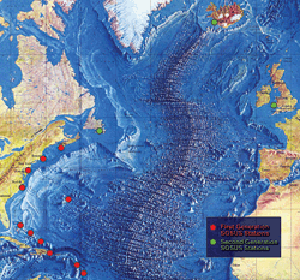
The Sound Surveillance System (SOSUS) was a submarine detection system based on passive sonar developed by the United States Navy to track Soviet submarines. The system's true nature was classified with the name and acronym SOSUS themselves classified. The unclassified name Project Caesar was used to cover the installation of the system and a cover story developed regarding the shore stations, identified only as a Naval Facility (NAVFAC), being for oceanographic research. In 1985, as the fixed bottom arrays were supplemented by the mobile Surveillance Towed Array Sensor System (SURTASS) and other new systems were coming on line, the name itself changed to Integrated Undersea Surveillance System (IUSS). The commands and personnel were covered by the "oceanographic" term until 1991 when the mission was declassified. As a result, the commands, Oceanographic System Atlantic and Oceanographic System Pacific became Undersea Surveillance Atlantic and Undersea Surveillance Pacific, and personnel were able to wear insignia reflecting the mission.

The Naval Undersea Warfare Center (NUWC) is the United States Navy's full-spectrum research, development, test and evaluation, engineering and fleet support center for submarines, autonomous underwater systems, and offensive and defensive weapons systems associated with undersea warfare. It is one of the corporate laboratories of the Naval Sea Systems Command. NUWC is headquartered in Newport, Rhode Island and has two major subordinate activities: Division Newport and Division Keyport in Keyport, Washington. NUWC also controls the Fox Island facility and Gould Island. It employs more than 4,400 civilian and military personnel, with budgets over $1 billion.

The SOFAR channel, or deep sound channel (DSC), is a horizontal layer of water in the ocean at which depth the speed of sound is at its minimum. The SOFAR channel acts as a waveguide for sound, and low frequency sound waves within the channel may travel thousands of miles before dissipating. An example was reception of coded signals generated by the Navy chartered ocean surveillance vessel Cory Chouest off Heard Island, located in the southern Indian Ocean, by hydrophones in portions of all five major ocean basins and as distant as the North Atlantic and North Pacific.

USNS Mizar (MA-48/T-AGOR-11/T-AK-272) was a vessel of the United States Navy. She was named after the star Mizar.

Naval Station Argentia is a former base of the United States Navy that operated from 1941 to 1994. It was established in the community of Argentia in what was then the Dominion of Newfoundland, which later became the tenth Canadian province, Newfoundland and Labrador.

Ramey Air Force Base is a former United States Air Force base in Aguadilla, Puerto Rico. It was named after United States Army Air Forces Brigadier General Howard Knox Ramey. Following its closure, it was redeveloped into Rafael Hernandez Airport.

Project Artemis was a United States Navy acoustics research and development experiment from the late 1950s into the mid 1960s to test a potential low-frequency active sonar system for ocean surveillance. The at sea testing began in 1960 after research and development in the late 1950s. The project's test requirement was to prove detection of a submerged submarine at 500 nmi. The experiment, covering a number of years, involved a large active element and a massive receiver array.

USNS Neptune (ARC-2), was the lead ship in her class of cable repair ships in U.S. Naval service. The ship was built by Pusey & Jones Corp. of Wilmington, Delaware, Hull Number 1108, as the USACS William H. G. Bullard named for Rear Adm. William H. G. Bullard. She was the first of two Maritime Commission type S3-S2-BP1 ships built for the US Army Signal Corps near the end of World War II. The other ship was the Albert J. Myer, which later joined her sister ship in naval service as the USNS Albert J. Myer (T-ARC-6).
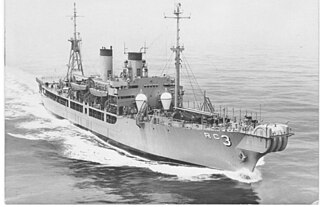
USS Aeolus (ARC-3) began service as USS Turandot (AKA-47), an Artemis-class attack cargo ship built by the Walsh-Kaiser Co., Inc. of Providence, Rhode Island. In 1954 she was converted into a cable repair ship to support Project Caesar, the unclassified name for installation of the Sound Surveillance System SOSUS. Aeolus was the first of two ships, the other being USS Thor (ARC-4), to be converted into cable ships. Aeolus performed cable duties for nearly thirty years, from 1955 to 1973 as a commissioned ship and from 1973 until 1985 as the civilian crewed USNS Aeolus (T-ARC-3) of the Military Sealift Command (MSC). The ship was retired in 1985 and sunk as an artificial reef in 1988.

Naval Facility Nantucket Island or simply Naval Facility Nantucket was a shore terminal of the Sound Surveillance System (SOSUS) active from 1955 to 1976. The true function of the system and the shore terminals, in which output of the array at sea was processed and displayed by means of the Low Frequency Analyzer and Recorder (LOFAR), was classified and the term "Naval Facility" was intentionally vague. Its function was described as oceanographic research.

Naval Facility (NAVFAC) Barbados, TWI, in commission 1957 to 1979, was the most southern of the Atlantic Sound Surveillance System (SOSUS) shore terminals. It had the distinction making the first system detection of a Soviet nuclear submarine in 1962 as that submarine was transiting off Norway. The facility was located adjacent to the Harrison Point Lighthouse, Parish of Saint Lucy.

USS Allegheny (ATA-179) was an American Sotoyomo-class auxiliary fleet tug launched in 1944 and serving until 1968. She underwent conversion to a research vessel in 1952.
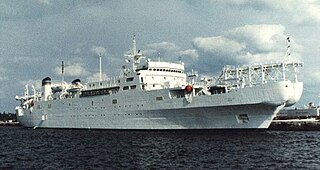
USNS Zeus (T-ARC-7) is the first cable ship specifically built for the United States Navy. Though planned to be the first of two ships of her class, the second ship was not built, leaving Zeus as the only ship of her class. She is capable of laying 1,000 miles (1,600 km) of cable at depths of up to 9,000 feet (2,700 m).
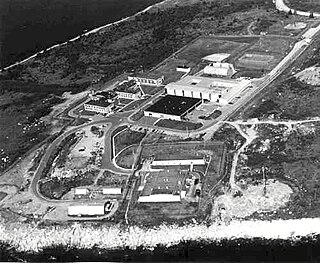
Canadian Forces Station (CFS) Shelburne is a former Canadian Forces Station that was a shore terminus for the Sound Surveillance System (SOSUS) from 1955 to 1994. It was located in the Municipality of the District of Shelburne, Shelburne County, Nova Scotia.

Naval Air Station Midway Island, also known as NAS Midway, Naval Air Facility Midway, and NAF Midway, was a U.S. Naval Air Station in the Midway Atoll, the northernmost group of the Hawaiian archipelago. It was in operation from 1941 to 1993, and played an important role in trans-Pacific aviation during those years. Through its lifetime, the facility was variously designated as a Naval Air Station, a Naval Air Facility, and a naval base. It was finally closed on 1 October 1993.

Argus Island was an acoustic research tower and platform located on Plantagenet Bank, a guyot about 30 miles southwest of the island of Bermuda. The tower was originally part of the facilities supporting Project Artemis and Project Trident under auspices of the Tudor Hill Laboratory, a facility of the US Navy's Underwater Sound Laboratory. Later the tower was used for additional acoustic experiments as well as oceanographic observations, wave height measurements, optical observations, air containment measurements and measurements of the effects of the ocean environment on the structure itself.

Naval Facility Cape Hatteras was a Sound Surveillance System (SOSUS) shore terminal, one of the nine initial systems installed, located on Cape Hatteras near Buxton, North Carolina and adjacent to the old location of the Cape Hatteras lighthouse. NAVFAC Cape Hatteras, eighth of the initial nine Atlantic systems to be activated, was in commission 11 January 1956 to 30 June 1982.

Naval Facility Point Sur was one of 30 secret sites worldwide that were built during the Cold War to detect Soviet submarines. In 1958, the U.S. Navy built a Naval Facility (NAVFAC) ½ mile south of Point Sur on the Big Sur coast to provide submarine surveillance using the classified SOund SUrveillance System (SOSUS). The public was told the station was engaged in oceanographic research.
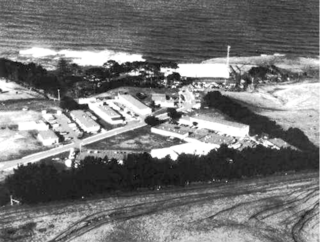
In 1958 Naval Facility (NAVFAC) Centerville Beach was the third Sound Surveillance System (SOSUS) shore terminal, in which output of the array at sea was processed and displayed by means of the Low Frequency Analyzer and Recorder (LOFAR), established on the Pacific coast. The previous year the last of the original Atlantic systems, Naval Facility Barbados, had become operational and the first of the Pacific systems had been installed at San Nicolas Island. Naval Facility Point Sur to the south had been commissioned on 8 January 1958. The SOSUS mission, as well as the name itself was classified until 1991. The facility was installed under the cover name Project Caesar and described as being engaged in "oceanographic research" with its actual role in undersea surveillance not revealed until two years before the facility closed.
Two closely related terms, Low Frequency Analyzer and Recorder and Low Frequency Analysis and Recording bearing the acronym LOFAR, deal with the equipment and process respectively for presenting a visual spectrum representation of low frequency sounds in a time–frequency analysis. The process was originally applied to fixed surveillance passive antisubmarine sonar systems and later to sonobuoy and other systems. Originally the analysis was electromechanical and the display was produced on electrostatic recording paper, a Lofargram, with stronger frequencies presented as lines against background noise. The analysis migrated to digital and both analysis and display were digital after a major system consolidation into centralized processing centers during the 1990s.




















